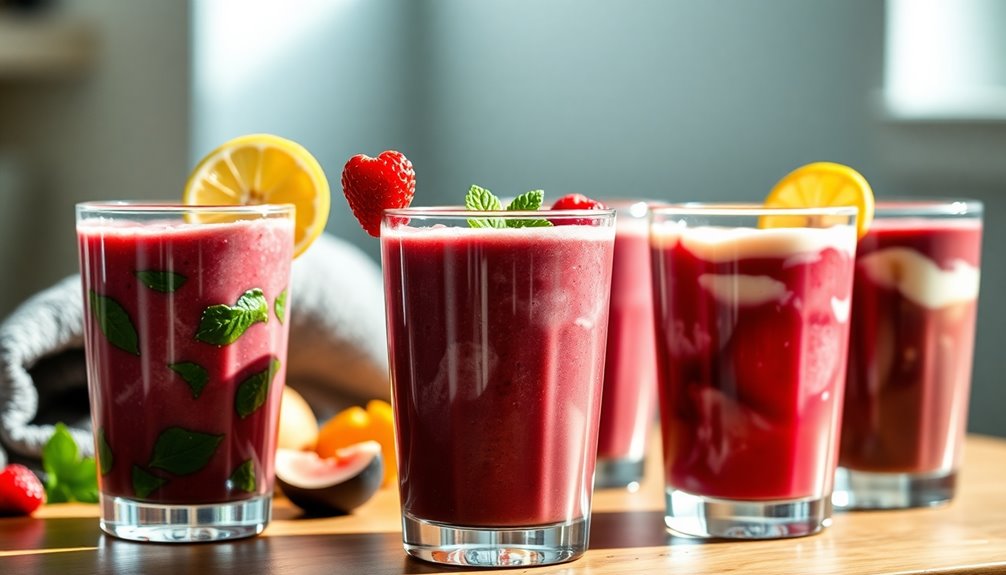Protein-packed smoothies are essential for your post-workout recovery. They help repair muscles, replenish glycogen stores, and absorb essential amino acids. Aim for a base of milk or yogurt, and add fruits like bananas or berries for vitamins. Incorporate protein sources such as Greek yogurt, whey protein, or plant-based options like pea protein. Try recipes like a Banana Almond Protein Smoothie or a Berry Spinach Powerhouse for a tasty boost. Experiment with flavors and textures to suit your taste and recovery goals. Want to know how to blend them perfectly and avoid common pitfalls? Keep exploring for more tips!
Key Takeaways
- Protein smoothies enhance post-workout recovery by providing essential amino acids and aiding muscle repair.
- Key ingredients include Greek yogurt, fruits, and plant-based proteins for optimal nutrition and flavor.
- Aim for 20-30 grams of protein in each smoothie to support recovery based on workout intensity.
- Customize smoothies with superfoods, nut butters, and spices for added health benefits and taste.
- Proper blending technique ensures a smooth texture and maximizes nutrient absorption for effective recovery.
Benefits of Protein Smoothies
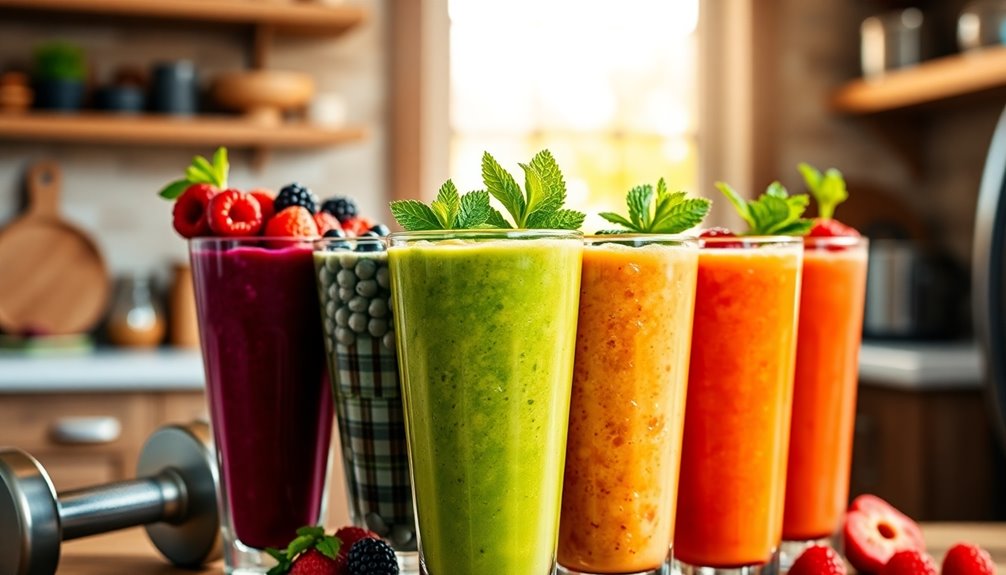
Protein smoothies offer a quick and effective way to boost your recovery after a workout. When you exercise, you put your muscles through stress, leading to micro-tears that require repair. Consuming a protein-rich smoothie immediately after your workout can greatly enhance muscle repair, making it a wise choice for anyone dedicated to their fitness journey.
Research shows that protein absorption is vital during the recovery phase. Your muscles crave amino acids to rebuild and strengthen themselves. By blending your preferred protein sources—like whey, plant-based proteins, or Greek yogurt—into a smoothie, you provide your body with the necessary nutrients it needs right when it needs them.
The liquid form of a smoothie also means your body can absorb those proteins more rapidly than solid foods, optimizing your recovery efforts.
In addition to muscle repair, these smoothies can help replenish glycogen stores, especially if you include carbohydrates like fruits or oats. This combination not only fuels your recovery but also readies you for your next workout session, creating a beneficial feedback loop.
Key Ingredients to Include
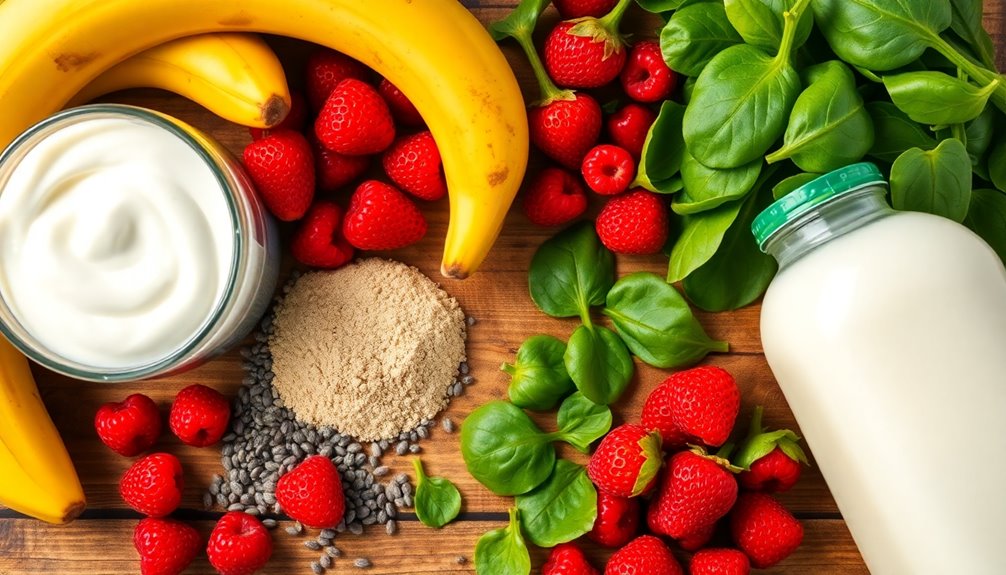
To create an effective post-workout smoothie, you'll want to focus on a blend of key ingredients that support recovery and enhance performance. Start with a base of your favorite milk or yogurt, which provides essential calcium and protein. Then, incorporate fruits like bananas or berries, packed with vitamins and antioxidants that aid in muscle recovery.
Don't forget about superfood additions! Ingredients like spinach, kale, or chia seeds boost your smoothie's nutritional profile significantly. Spinach is rich in iron, while chia seeds are loaded with omega-3 fatty acids and fiber, making them fantastic for hydration and energy replenishment.
For flavor combinations, think outside the box. Combining pineapple with coconut milk can give your smoothie a tropical twist, while mixing strawberries and almond butter offers a delicious, nutty flavor.
You can also experiment with spices like cinnamon or ginger, which not only enhance taste but also have anti-inflammatory properties.
Protein Sources for Smoothies

Building on that solid foundation of key ingredients, incorporating quality protein sources into your smoothie can greatly enhance recovery. Whether you're a seasoned athlete or just getting started, choosing the right protein can help rebuild muscle and replenish energy. Here are some excellent protein sources to contemplate:
| Protein Source | Type | Benefits |
|---|---|---|
| Greek Yogurt | Dairy Alternative | High in protein; provides probiotics |
| Pea Protein Powder | Plant-Based Option | Rich in essential amino acids; vegan |
| Almond Milk | Dairy Alternative | Low in calories; adds subtle flavor |
Greek yogurt is a fantastic dairy alternative that not only packs a protein punch but also contains probiotics, which support gut health. If you're leaning towards plant-based options, pea protein powder is an excellent choice, offering a complete amino acid profile without any animal products. It's perfect for those who follow a vegan lifestyle.
Another great option is almond milk, which serves as a delicious base for your smoothies. While it's lower in protein than other sources, you can easily boost the protein content by combining it with other ingredients.
Top Smoothie Recipes
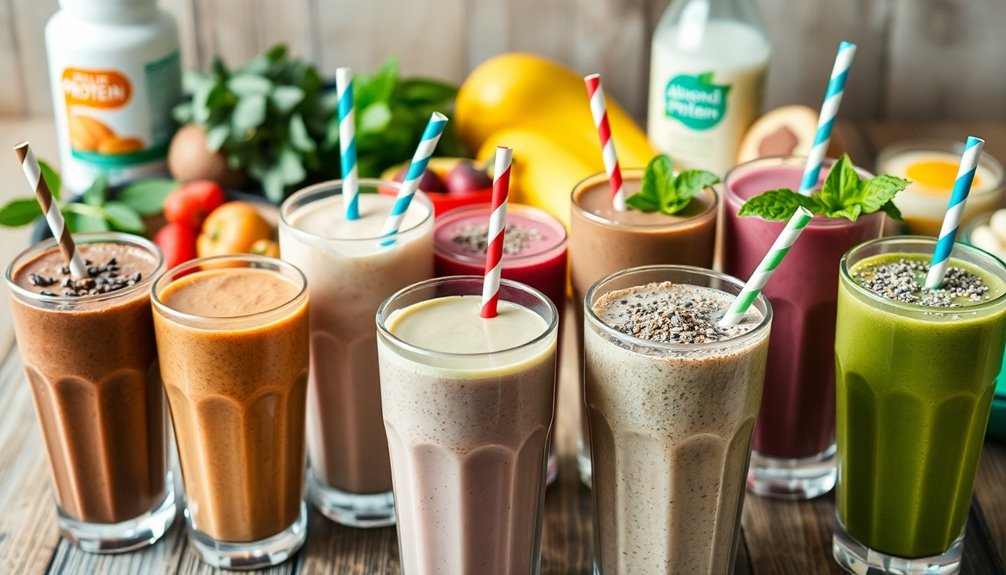
Smoothie recipes packed with nutrition can be game-changers for your post-workout recovery. They not only replenish your energy levels but also support muscle repair and growth. Here are some top smoothie recipes that incorporate effective nutrient combinations to enhance your recovery routine.
First up is the Banana Almond Protein Smoothie. Blend one ripe banana, a tablespoon of almond butter, a scoop of your favorite protein powder, and a cup of unsweetened almond milk. This smoothie variation provides potassium from the banana, healthy fats from the almond butter, and protein for muscle recovery.
Next, try the Berry Spinach Powerhouse. Combine a cup of mixed berries, a handful of fresh spinach, Greek yogurt, and a splash of orange juice. The berries are rich in antioxidants, while spinach adds iron, and yogurt offers a great source of protein and probiotics.
For a tropical twist, whip up the Mango Coconut Recovery Smoothie. Blend one cup of frozen mango, half a cup of coconut water, a scoop of vanilla protein powder, and a tablespoon of chia seeds. The coconut water hydrates, while chia seeds provide omega-3 fatty acids and additional protein.
Each of these smoothies offers unique nutrient combinations tailored to support your recovery needs. Experiment with these recipes, and feel free to explore different smoothie variations to discover what works best for you. Embrace the journey of recovery, and enjoy the delicious, nutritious benefits these smoothies provide!
Customizing Your Smoothie
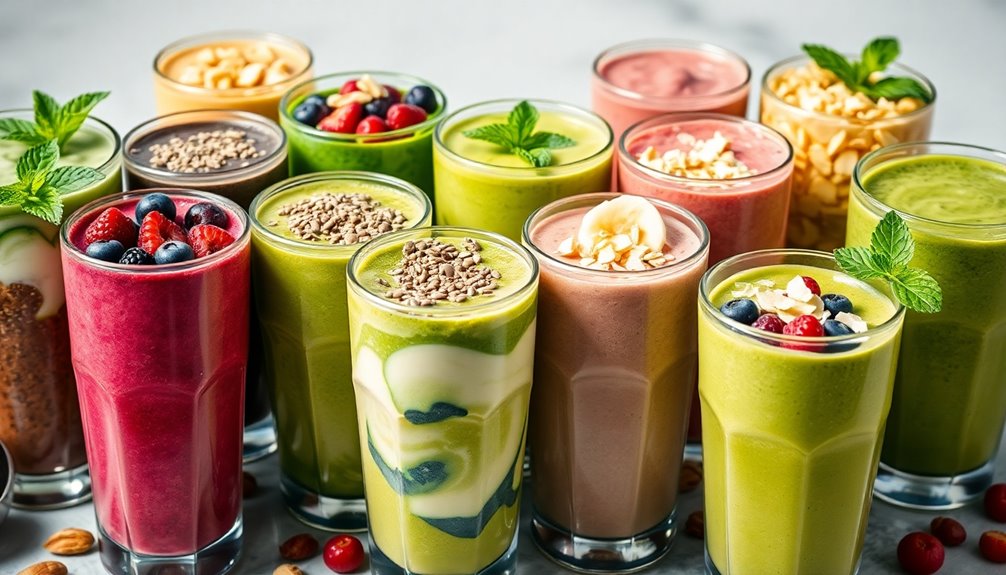
Customizing your smoothie can transform it into a powerhouse of nutrition tailored specifically to your recovery needs. By selecting the right ingredients, you can create a delicious blend that not only fuels your body but also satisfies your taste buds.
Start by considering your flavor combinations. Whether you prefer fruity, nutty, or even a hint of spice, the possibilities are endless. For instance, blending banana with spinach and almond butter offers a sweet yet nutritious option, while adding a dash of cinnamon can enhance the flavor profile.
Next, think about your texture preferences. Some people love a creamy smoothie, while others might prefer a thicker, more substantial drink. If you're aiming for creaminess, opt for ingredients like yogurt or avocado. For a thicker texture, frozen fruits or oats work wonders. Experimenting with these elements allows you to find the perfect balance that feels right for you, making each post-workout smoothie a personal delight.
Don't forget to incorporate protein sources that fit your goals. Whether you choose whey, plant-based protein, or Greek yogurt, make sure it aligns with your dietary preferences. Adding chia seeds or nut butter can boost protein content and provide healthy fats for sustained energy.
Timing Your Post-Workout Nutrition
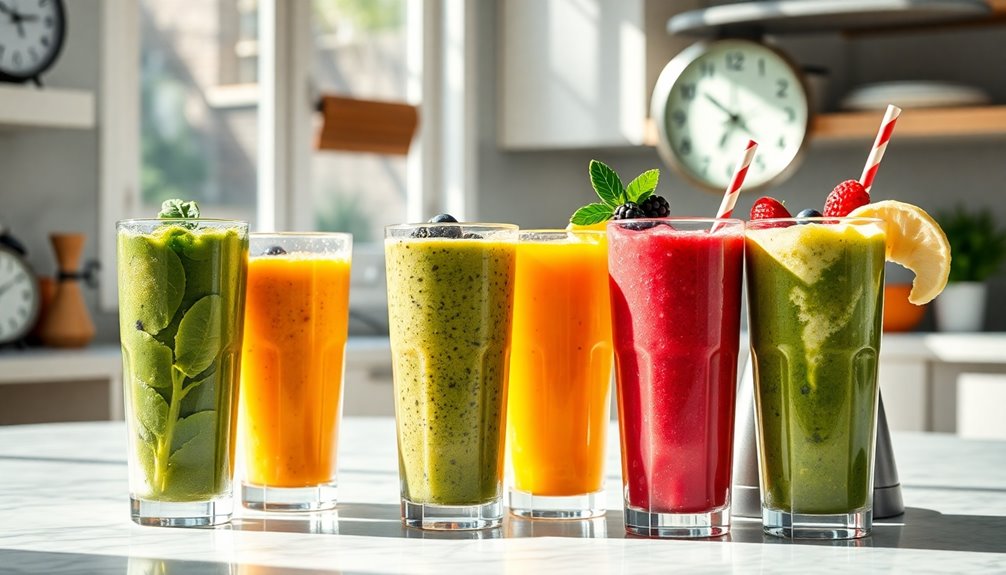
After an intense workout, timing your nutrition is important for best recovery. To enhance muscle repair and ensure peak recovery, you should aim to refuel within 30 to 60 minutes post-exercise. This window is vital because your muscles are primed to absorb nutrients, making post-exercise fueling especially effective during this period.
When you work out, your body depletes glycogen stores and breaks down muscle proteins. Consuming a combination of protein and carbohydrates shortly after your workout helps replenish these glycogen stores and jump-starts the muscle repair process.
Research suggests that a ratio of about 3:1 carbohydrates to protein is ideal for recovery smoothies. This balance not only aids in quicker recovery but also prepares your body for future workouts.
Nutrient timing isn't just about what you eat; it's also about when you eat. If you wait too long, you might miss the opportunity for your muscles to utilize the nutrients effectively, which can delay recovery.
Common Mistakes to Avoid
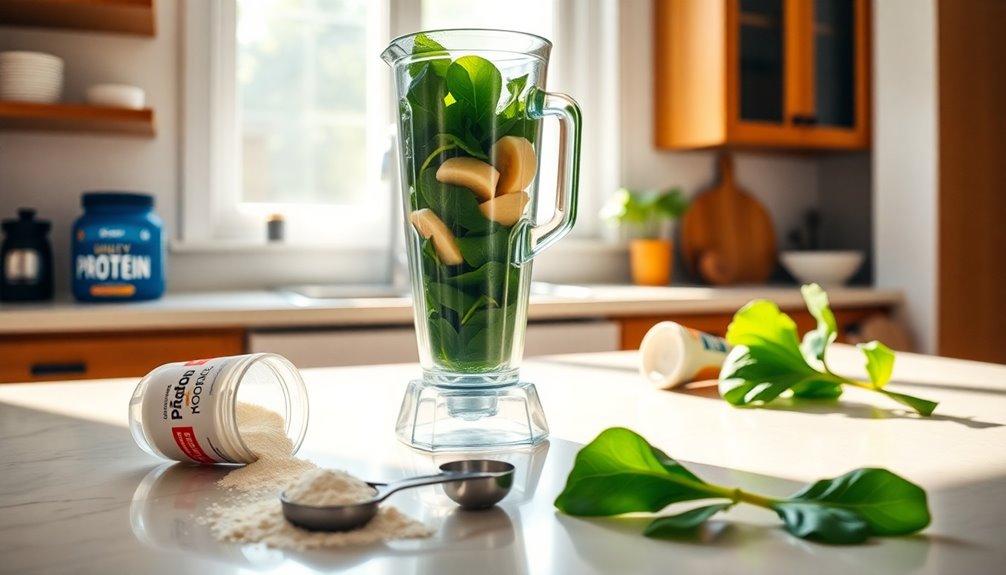
When crafting your post-workout smoothie, it's easy to make some common mistakes that can undermine your recovery efforts. One major pitfall isn't paying attention to protein ratios. Ideally, you should aim for a balance of protein and carbohydrates to effectively replenish your muscles. Many people underestimate their protein needs, which can lead to inadequate recovery. A good rule of thumb is to include around 20-30 grams of protein in your smoothie, depending on your weight and workout intensity.
Another mistake is the choice of liquid options. Some people default to high-sugar juices or flavored yogurts, which can negate the health benefits of your smoothie. Instead, consider using unsweetened almond milk or coconut water, as they provide hydration without excess sugar. If you go for dairy, opt for low-fat milk or Greek yogurt, both of which offer a protein boost while keeping the sugar content under control.
Lastly, don't skip the greens! Many people overlook the nutritional power of spinach or kale. Adding a handful can enhance the vitamin and mineral content of your smoothie, promoting better recovery.
Tips for Blending Perfection
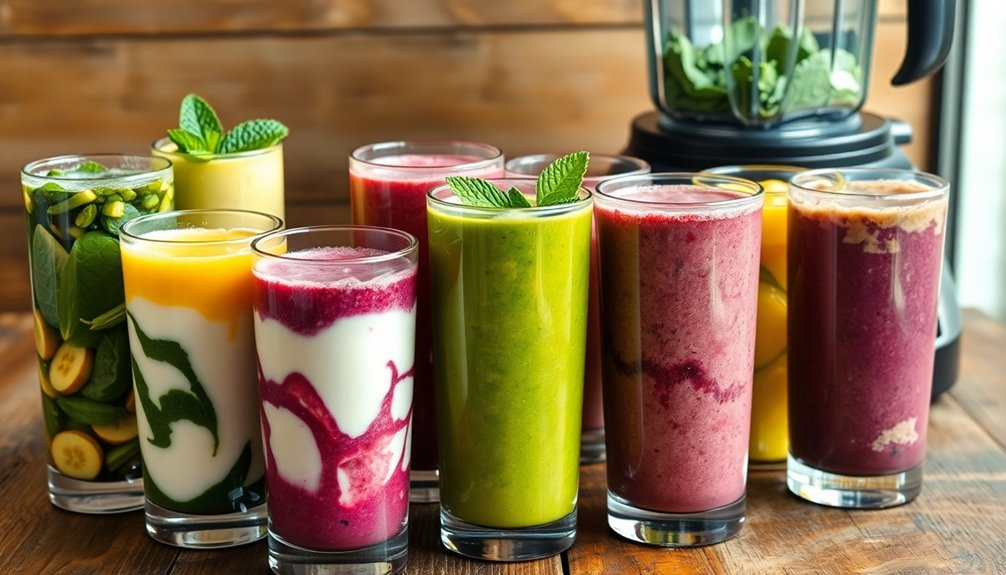
Achieving blending perfection for your post-workout smoothie can elevate your recovery routine substantially. When you nail the right smoothie consistency and flavor combinations, you not only enjoy your drink more but also maximize its nutritional balance. Here are four essential tips to help you mix like a pro:
- Layer Wisely: Start with liquids at the bottom to guarantee smoother blending. Follow with softer ingredients, and finish with frozen fruits or spinach on top. This technique helps create a better texture.
- Control the Speed: Use a variable-speed blender and start slow. Gradually increase the speed to break down ingredients thoroughly. This method enhances the smoothie consistency and reduces chunks.
- Experiment with Flavors: Don't be afraid to mix and match! Try adding spices like cinnamon or ginger to enhance your flavor combinations. You'll be surprised at how a dash of something unexpected can transform your smoothie.
- Balance Your Nutrients: Incorporate protein sources like Greek yogurt or a protein powder to guarantee nutritional balance. Pair this with healthy fats like avocado or nut butter for a creamy texture and sustained energy.
Frequently Asked Questions
Can I Use Plant-Based Protein Powders in Smoothies?
Absolutely, you can use plant-based protein powders in smoothies! They offer numerous benefits, including being easier on digestion and packed with essential nutrients. Plus, they come in a variety of flavors.
For the best flavor combinations, try mixing chocolate protein powder with banana and almond milk, or vanilla protein with berries and spinach. These combinations not only taste great but also provide a nutritious boost that keeps you feeling satisfied and energized.
How Can I Make a Smoothie Dairy-Free?
If you're craving a smoothie that's creamy and delicious, while keeping it dairy-free, you've got options!
Start with nut milk alternatives like almond, cashew, or coconut milk as your base.
For added sweetness and flavor, consider fruit substitutions such as bananas or avocados.
Blend these ingredients together, and you'll create a satisfying, nutritious drink that fits your lifestyle.
Enjoy the camaraderie of sharing recipes and bonding over your tasty creations!
Are There Any Allergens to Be Aware Of?
When considering allergens, you should be mindful of common allergens like nuts, soy, and gluten. These can trigger reactions in sensitive individuals.
It's also crucial to address nutritional considerations; some ingredients may not only contain allergens but also impact your smoothie's overall balance.
Always read labels carefully and choose ingredients that align with your dietary needs.
Creating a safe and inclusive environment for everyone guarantees everyone can enjoy their smoothies without worry.
How Long Can I Store a Smoothie For?
You might be surprised to learn that smoothies can last longer than you think! If you store them in the fridge, their shelf life is about 1 to 3 days, but freezing smoothies can extend that to up to 3 months.
Just blend your favorite ingredients, pour into a container, and pop it in the freezer. When you're ready to enjoy, just thaw it out and shake it up for a revitalizing treat!
Can I Replace Meals With Protein Smoothies?
You can replace meals with protein smoothies, but it's crucial to take into account their nutritional value.
It's vital to make sure your smoothies contain a balance of proteins, healthy fats, and carbohydrates to sustain satiety levels throughout the day.
If you're utilizing smoothies as meal replacements, incorporate nutrient-rich ingredients like fruits, vegetables, and seeds.
This way, you'll feel satisfied and nourished, promoting your overall health and well-being while seamlessly integrating into your lifestyle.
Conclusion
Incorporating protein-packed smoothies into your post-workout routine can greatly enhance recovery and muscle growth. Research shows that consuming protein within 30 minutes after exercising can boost muscle synthesis by up to 25%. By blending the right ingredients and timing your nutrition, you'll maximize your results and feel the benefits faster. Remember, it's about fueling your body properly to support your fitness goals. So grab those ingredients and start blending – your muscles will thank you!

